Biochar-Added Cementitious Materials—A Review on Mechanical, Thermal, and Environmental Properties
Abstract
:1. Introduction
2. Biochar
2.1. Fire, Mechanical, and Thermal Properties of Biochar
2.2. Concrete Background
3. Review of Biochar/Concrete Composites
3.1. Microstructure and Interfacial Bonding in Biochar/Cementitious Materials
3.2. Mechanical Properties of Biochar/Cementitious Materials
3.2.1. Compression Strength
3.2.2. Flexural Strength
3.2.3. Tensile Strength
3.3. Thermal Behaviour of Biochar/Cementitious Material
4. Life Cycle Assessment (LCA) of Biochar/Concrete
5. Economic Benefits
6. Fire Properties
7. Conclusions
Author Contributions
Funding
Institutional Review Board Statement
Informed Consent Statement
Data Availability Statement
Conflicts of Interest
References
- The Warming Effects of the Industrial Revolution-Global Temperatures. Available online: https://www.climate-policy-watcher.org/global-temperatures/the-warming-effects-of-the-industrial-revolution.html (accessed on 31 May 2021).
- Climate Change: Atmospheric Carbon Dioxide|NOAA Climate.gov. Available online: https://www.climate.gov/news-features/understanding-climate/climate-change-atmospheric-carbon-dioxide (accessed on 31 May 2021).
- Lüthi, D.; Le Floch, M.; Bereiter, B.; Blunier, T.; Barnola, J.M.; Siegenthaler, U.; Raynaud, D.; Jouzel, J.; Fischer, H.; Kawamura, K.; et al. High-resolution carbon dioxide concentration record 650,000–800,000 years before present. Nature 2008, 453, 379–382. [Google Scholar] [CrossRef] [PubMed]
- Gupta, S.; Kua, H.W.; Low, C.Y. Use of biochar as carbon sequestering additive in cement mortar. Cem. Concr. Compos. 2018, 87, 110–129. [Google Scholar] [CrossRef]
- Worrell, E.; Price, L.; Martin, N.; Hendriks, C.; Meida, L.O. Carbon dioxide emissions from the global cement industry. Annu. Rev. Energy Environ. 2001, 26, 303–329. [Google Scholar] [CrossRef]
- Oh, D.Y.; Noguchi, T.; Kitagaki, R.; Park, W.J. CO2 emission reduction by reuse of building material waste in the Japanese cement industry. Renew. Sustain. Energy Rev. 2014, 38, 796–810. [Google Scholar] [CrossRef]
- Global Cement Industry CO2 Emissions 2019|Statista. Available online: https://www.statista.com/statistics/1091672/carbon-dioxide-emissions-global-cement-manufacturing/ (accessed on 31 May 2021).
- Naqi, A.; Jang, J.G. Recent progress in green cement technology utilizing low-carbon emission fuels and raw materials: A review. Sustainability 2019, 11, 537. [Google Scholar] [CrossRef]
- Feiz, R.; Ammenberg, J.; Baas, L.; Eklund, M.; Helgstrand, A.; Marshall, R. Improving the CO2 performance of cement, part I: Utilizing life-cycle assessment and key performance indicators to assess development within the cement industry. J. Clean. Prod. 2015, 98, 272–281. [Google Scholar] [CrossRef]
- Boesch, M.E.; Hellweg, S. Identifying improvement potentials in cement production with life cycle assessment. Environ. Sci. Technol. 2010, 44, 9143–9149. [Google Scholar] [CrossRef] [PubMed]
- Ammenberg, J.; Baas, L.; Eklund, M.; Feiz, R.; Helgstrand, A.; Marshall, R. Improving the CO2 performance of cement, part III: The relevance of industrial symbiosis and how to measure its impact. J. Clean. Prod. 2015, 98, 145–155. [Google Scholar] [CrossRef]
- Miller, S.A.; John, V.M.; Pacca, S.A.; Horvath, A. Carbon dioxide reduction potential in the global cement industry by 2050. Cem. Concr. Res. 2018, 114, 115–124. [Google Scholar] [CrossRef]
- Zhang, J.; Liu, G.; Chen, B.; Song, D.; Qi, J.; Liu, X. Analysis of CO2 Emission for the cement manufacturing with alternative raw materials: A LCA-based framework. Energy Procedia 2014, 61, 2541–2545. [Google Scholar] [CrossRef]
- Hossain, M.U.; Poon, C.S.; Lo, I.M.C.; Cheng, J.C.P. Comparative LCA on using waste materials in the cement industry: A Hong Kong case study. Resour. Conserv. Recycl. 2017, 120, 199–208. [Google Scholar] [CrossRef]
- Manjunatha, M.; Preethi, S.; Mounika, H.G.; Niveditha, K.N. Ravi Life cycle assessment (LCA) of concrete prepared with sustainable cement-based materials. Mater. Today Proc. 2021. [Google Scholar] [CrossRef]
- Boix, E.; Gineau, E.; Narciso, J.O.; Höfte, H.; Mouille, G.; Navard, P. Influence of chemical treatments of miscanthus stem fragments on polysaccharide release in the presence of cement and on the mechanical properties of bio-based concrete materials. Cem. Concr. Compos. 2020, 105, 103429. [Google Scholar] [CrossRef]
- Chennouf, N.; Agoudjil, B.; Alioua, T.; Boudenne, A.; Benzarti, K. Experimental investigation on hygrothermal performance of a bio-based wall made of cement mortar filled with date palm fibers. Energy Build. 2019, 202, 109413. [Google Scholar] [CrossRef]
- van der Bergh, J.M.; Miljević, B.; Šovljanski, O.; Vučetić, S.; Markov, S.; Ranogajec, J.; Bras, A. Preliminary approach to bio-based surface healing of structural repair cement mortars. Constr. Build. Mater. 2020, 248, 118557. [Google Scholar] [CrossRef]
- Sierra-Beltran, M.G.; Jonkers, H.M.; Schlangen, E. Characterization of sustainable bio-based mortar for concrete repair. Constr. Build. Mater. 2014, 67, 344–352. [Google Scholar] [CrossRef]
- Williams, S.L.; Kirisits, M.J.; Ferron, R.D. Optimization of growth medium for Sporosarcina pasteurii in bio-based cement pastes to mitigate delay in hydration kinetics. J. Ind. Microbiol. Biotechnol. 2016, 43, 567–575. [Google Scholar] [CrossRef] [PubMed]
- Lamas, W.D.Q.; Palau, J.C.F.; De Camargo, J.R. Waste materials co-processing in cement industry: Ecological efficiency of waste reuse. Renew. Sustain. Energy Rev. 2013, 19, 200–207. [Google Scholar] [CrossRef]
- Li, X.D.; Poon, C.S.; Sun, H.; Lo, I.M.C.; Kirk, D.W. Heavy metal speciation and leaching behaviors in cement based solidified/stabilized waste materials. J. Hazard. Mater. 2001, 82, 215–230. [Google Scholar] [CrossRef]
- Hossain, N.; Bhuiyan, M.A.; Pramanik, B.K.; Nizamuddin, S.; Griffin, G. Waste materials for wastewater treatment and waste adsorbents for biofuel and cement supplement applications: A critical review. J. Clean. Prod. 2020, 255, 120261. [Google Scholar] [CrossRef]
- He, Z.; Shen, A.; Wu, H.; Wang, W.; Wang, L.; Yao, C.; Wu, J. Research progress on recycled clay brick waste as an alternative to cement for sustainable construction materials. Constr. Build. Mater. 2021, 274, 122113. [Google Scholar] [CrossRef]
- Chore, H.S.; Joshi, M.P. Strength characterization of concrete using industrial waste as cement replacing materials for rigid pavement. Innov. Infrastruct. Solut. 2020, 5, 1–9. [Google Scholar] [CrossRef]
- Rattanachu, P.; Toolkasikorn, P.; Tangchirapat, W.; Chindaprasirt, P.; Jaturapitakkul, C. Performance of recycled aggregate concrete with rice husk ash as cement binder. Cem. Concr. Compos. 2020, 108, 103533. [Google Scholar] [CrossRef]
- Hu, L.; He, Z.; Zhang, S. Sustainable use of rice husk ash in cement-based materials: Environmental evaluation and performance improvement. J. Clean. Prod. 2020, 264, 121744. [Google Scholar] [CrossRef]
- Islam, M.S.; Elahi, T.E.; Shahriar, A.R.; Mumtaz, N. Effectiveness of fly ash and cement for compressed stabilized earth block construction. Constr. Build. Mater. 2020, 255, 119392. [Google Scholar] [CrossRef]
- Liang, S.; Chen, J.; Guo, M.; Feng, D.; Liu, L.; Qi, T. Utilization of pretreated municipal solid waste incineration fly ash for cement-stabilized soil. Waste Manag. 2020, 105, 425–432. [Google Scholar] [CrossRef]
- Akinyemi, B.A.; Dai, C. Development of banana fibers and wood bottom ash modified cement mortars. Constr. Build. Mater. 2020, 241, 118041. [Google Scholar] [CrossRef]
- Carević, I.; Baričević, A.; Štirmer, N.; Šantek Bajto, J. Correlation between physical and chemical properties of wood biomass ash and cement composites performances. Constr. Build. Mater. 2020, 256, 119450. [Google Scholar] [CrossRef]
- Wu, F.; Yu, Q.; Liu, C. Durability of thermal insulating bio-based lightweight concrete: Understanding of heat treatment on bio-aggregates. Constr. Build. Mater. 2021, 269, 121800. [Google Scholar] [CrossRef]
- Wei, J.; Meyer, C. Degradation mechanisms of natural fiber in the matrix of cement composites. Cem. Concr. Res. 2015, 73, 1–16. [Google Scholar] [CrossRef]
- Singh, H.; Gupta, R. Influence of cellulose fiber addition on self-healing and water permeability of concrete. Case Stud. Constr. Mater. 2020, 12, e00324. [Google Scholar] [CrossRef]
- Ou, Z.H.; Ma, B.G.; Jian, S.W. Influence of cellulose ethers molecular parameters on hydration kinetics of Portland cement at early ages. Constr. Build. Mater. 2012, 33, 78–83. [Google Scholar] [CrossRef]
- Chandrasekhar, S.; Pramada, P.N.; Majeed, J. Effect of calcination temperature and heating rate on the optical properties and reactivity of rice husk ash. J. Mater. Sci. 2006, 41, 7926–7933. [Google Scholar] [CrossRef]
- Ramamurthy, K.; Harikrishnan, K.I. Influence of binders on properties of sintered fly ash aggregate. Cem. Concr. Compos. 2006, 28, 33–38. [Google Scholar] [CrossRef]
- Das, O.; Sarmah, A.K.; Bhattacharyya, D. Structure-mechanics property relationship of waste derived biochars. Sci. Total Environ. 2015, 538, 611–620. [Google Scholar] [CrossRef] [PubMed]
- Maljaee, H.; Madadi, R.; Paiva, H.; Tarelho, L.; Ferreira, V.M. Incorporation of biochar in cementitious materials: A roadmap of biochar selection. Constr. Build. Mater. 2021, 283, 122757. [Google Scholar] [CrossRef]
- Akinyemi, B.; Adesina, A. Recent advancements in the use of biochar for cementitious applications: A review. J. Build. Eng. 2020, 32, 101705. [Google Scholar] [CrossRef]
- Lee, S.Y.; Sankaran, R.; Chew, K.W.; Tan, C.H.; Krishnamoorthy, R.; Chu, D.-T.; Show, P.-L. Waste to bioenergy: A review on the recent conversion technologies. BMC Energy 2019, 1, 4. [Google Scholar] [CrossRef]
- Antar, M.; Lyu, D.; Nazari, M.; Shah, A.; Zhou, X.; Smith, D.L. Biomass for a sustainable bioeconomy: An overview of world biomass production and utilization. Renew. Sustain. Energy Rev. 2021, 139, 110691. [Google Scholar] [CrossRef]
- Vigneshwaran, S.; Sundarakannan, R.; John, K.M.; Joel Johnson, R.D.; Prasath, K.A.; Ajith, S.; Arumugaprabu, V.; Uthayakumar, M. Recent advancement in the natural fiber polymer composites: A comprehensive review. J. Clean. Prod. 2020, 277, 124109. [Google Scholar] [CrossRef]
- Cha, J.S.; Park, S.H.; Jung, S.-C.; Ryu, C.; Jeon, J.-K.; Shin, M.-C.; Park, Y.-K. Production and utilization of biochar: A review. J. Ind. Eng. Chem. 2016, 40, 1–15. [Google Scholar] [CrossRef]
- Tomczyk, A.; Sokołowska, Z.; Boguta, P. Biochar physicochemical properties: Pyrolysis temperature and feedstock kind effects. Rev. Environ. Sci. Biotechnol. 2020, 19, 191–215. [Google Scholar] [CrossRef]
- Liu, N.; Charrua, A.B.; Weng, C.H.; Yuan, X.; Ding, F. Characterization of biochars derived from agriculture wastes and their adsorptive removal of atrazine from aqueous solution: A comparative study. Bioresour. Technol. 2015, 198, 55–62. [Google Scholar] [CrossRef] [PubMed]
- Das, O.; Kim, N.K.; Hedenqvist, M.S.; Lin, R.J.T.; Sarmah, A.K.; Bhattacharyya, D. An Attempt to Find a Suitable Biomass for Biochar-Based Polypropylene Biocomposites. Environ. Manag. 2018, 62, 403–413. [Google Scholar] [CrossRef] [PubMed]
- Giorcelli, M.; Khan, A.; Pugno, N.M.; Rosso, C.; Tagliaferro, A. Biomass and Bioenergy Biochar as a cheap and environmental friendly fi ller able to improve polymer mechanical properties. Biomass Bioenergy 2019, 120, 219–223. [Google Scholar] [CrossRef]
- Tan, R.R. Data challenges in optimizing biochar-based carbon sequestration. Renew. Sustain. Energy Rev. 2019, 104, 174–177. [Google Scholar] [CrossRef]
- Sizmur, T.; Quilliam, R.; Puga, A.P.; Moreno-Jiménez, E.; Beesley, L.; Gomez-Eyles, J.L. Application of Biochar for Soil Remediation. In Agricultural and Environmental Applications of Biochar: Advances and Barriers; Soil Science Society of America, Inc.: Madison, WI, USA, 2015; pp. 295–324. [Google Scholar]
- Li, S.; Bi, X.; Tao, R.; Wang, Q.; Yao, Y.; Wu, F.; Zhang, C. Ultralong Cycle Life Achieved by a Natural Plant: Miscanthus × giganteus for Lithium Oxygen Batteries. ACS Appl. Mater. Interfaces 2017, 9, 4382–4390. [Google Scholar] [CrossRef] [PubMed]
- Ronsse, F.; van Hecke, S.; Dickinson, D.; Prins, W. Production and characterization of slow pyrolysis biochar: Influence of feedstock type and pyrolysis conditions. GCB Bioenergy 2013, 5, 104–115. [Google Scholar] [CrossRef]
- Zhao, S.X.; Ta, N.; Wang, X.D. Effect of Temperature on the Structural and Physicochemical Properties of Biochar with Apple Tree Branches as Feedstock Material. Energies 2017, 10, 1293. [Google Scholar] [CrossRef]
- Das, O.; Kim, N.K.; Sarmah, A.K.; Bhattacharyya, D. Development of waste based biochar/wool hybrid biocomposites: Flammability characteristics and mechanical properties. J. Clean. Prod. 2017, 144, 79–89. [Google Scholar] [CrossRef]
- Liu, Z.; Fei, B.; Jiang, Z.; Liu, X. Combustion characteristics of bamboo-biochars. Bioresour. Technol. 2014, 167, 94–99. [Google Scholar] [CrossRef]
- Kumar, M.; Verma, B.B.; Gupta, R.C. Mechanical Properties of Acacia and Eucalyptus Wood Chars. Energy Source 1999, 21, 675–685. [Google Scholar] [CrossRef]
- Zickler, G.A.; Schöberl, T.; Paris, O. Mechanical properties of pyrolysed wood: A nanoindentation study. Philos. Mag. 2006, 86, 1373–1386. [Google Scholar] [CrossRef]
- Yang, X.; Wang, H.; Strong, P.; Xu, S.; Liu, S.; Lu, K.; Sheng, K.; Guo, J.; Che, L.; He, L.; et al. Thermal Properties of Biochars Derived from Waste Biomass Generated by Agricultural and Forestry Sectors. Energies 2017, 10, 469. [Google Scholar] [CrossRef]
- Hankalin, V.; Ahonen, T.; Raiko, R. On Thermal Properties of a Pyrolysing Wood Particle. Process Eng. 2009, 16, 1–20. [Google Scholar]
- Gupta, M.; Yang, J.; Roy, C. Specific heat and thermal conductivity of softwood bark and softwood char particles☆. Fuel 2003, 82, 919–927. [Google Scholar] [CrossRef]
- Pyle, D.L.; Zaror, C.A. Heat transfer and kinetics in the low temperature pyrolysis of solids. Chem. Eng. Sci. 1984, 39, 147–158. [Google Scholar] [CrossRef]
- Dupont, C.; Chiriac, R.; Gauthier, G.; Toche, F. Heat capacity measurements of various biomass types and pyrolysis residues. Fuel 2014, 115, 644–651. [Google Scholar] [CrossRef]
- Jiang, X.; Li, B.; Li, J.; Guo, J. Study on the properties of different biochar to cement paste. In IOP Conference Series: Earth and Environmental Science; IOP Publishing: Bristol, UK, 2020; Volume 526. [Google Scholar] [CrossRef]
- Li, V.C. On Engineered Cementitious Composites (ECC). J. Adv. Concr. Technol. 2003, 1, 215–230. [Google Scholar] [CrossRef]
- Research and Markets, World Cement and Concrete Product Market Outlook 2020–2030. Available online: https://www.globenewswire.com/en/news-release/2020/12/16/2146561/28124/en/World-Cement-and-Concrete-Product-Market-Outlook-2020-2030-A-441-7-Billion-Global-Market-by-2023.html#:~:text=The%20global%20cement%20and%20concrete%20product%20market%20is%20expected%20to,the%20measures%20to%20contain%20it (accessed on 31 May 2021).
- Akhtar, A.; Sarmah, A.K. Novel biochar-concrete composites: Manufacturing, characterization and evaluation of the mechanical properties. Sci. Total Environ. 2018, 616–617, 408–416. [Google Scholar] [CrossRef] [PubMed]
- Imbabi, M.S.; Carrigan, C.; McKenna, S. Trends and developments in green cement and concrete technology. Int. J. Sustain. Built Environ. 2012, 1, 194–216. [Google Scholar] [CrossRef]
- Lu, L.H.; Pan, G.S.; Chen, S.L.; Zhang, Y. Strength of concrete with different contents of fly ash. J. Shenyang Univ. Technol. 2009, 31, 107–111. [Google Scholar]
- Kriker, A.; Bali, A.; Debicki, G.; Bouziane, M.; Chabannet, M. Durability of date palm fibres and their use as reinforcement in hot dry climates. Cem. Concr. Compos. 2008, 30, 639–648. [Google Scholar] [CrossRef]
- Gupta, S.; Kua, H.W.; Tan Cynthia, S.Y. Use of biochar-coated polypropylene fibers for carbon sequestration and physical improvement of mortar. Cem. Concr. Compos. 2017, 83, 171–187. [Google Scholar] [CrossRef]
- Gupta, S.; Kua, H.W.; Pang, S.D. Biochar-mortar composite: Manufacturing, evaluation of physical properties and economic viability. Constr. Build. Mater. 2018, 167, 874–889. [Google Scholar] [CrossRef]
- Ahmad, M.R.; Chen, B.; Duan, H. Improvement effect of pyrolyzed agro-food biochar on the properties of magnesium phosphate cement. Sci. Total Environ. 2020, 718, 137422. [Google Scholar] [CrossRef]
- Wang, L.; Chen, L.; Tsang, D.C.W.; Kua, H.W.; Yang, J.; Ok, Y.S.; Ding, S.; Hou, D.; Poon, C.S. The roles of biochar as green admixture for sediment-based construction products. Cem. Concr. Compos. 2019, 104, 103348. [Google Scholar] [CrossRef]
- Gupta, S.; Muthukrishnan, S.; Kua, H.W. Comparing influence of inert biochar and silica rich biochar on cement mortar – Hydration kinetics and durability under chloride and sulfate environment. Constr. Build. Mater. 2021, 268, 121142. [Google Scholar] [CrossRef]
- Wang, L.; Chen, L.; Tsang, D.C.W.; Guo, B.; Yang, J.; Shen, Z.; Hou, D.; Ok, Y.S.; Poon, C.S. Biochar as green additives in cement-based composites with carbon dioxide curing. J. Clean. Prod. 2020, 258, 120678. [Google Scholar] [CrossRef]
- Gupta, S.; Kua, H.W. Effect of water entrainment by pre-soaked biochar particles on strength and permeability of cement mortar. Constr. Build. Mater. 2018, 159, 107–125. [Google Scholar] [CrossRef]
- Asadi Zeidabadi, Z.; Bakhtiari, S.; Abbaslou, H.; Ghanizadeh, A.R. Synthesis, characterization and evaluation of biochar from agricultural waste biomass for use in building materials. Constr. Build. Mater. 2018, 181, 301–308. [Google Scholar] [CrossRef]
- Cuthbertson, D.; Berardi, U.; Briens, C.; Berruti, F. Biochar from residual biomass as a concrete filler for improved thermal and acoustic properties. Biomass Bioenergy 2019, 120, 77–83. [Google Scholar] [CrossRef]
- Ahmad, S.; Khushnood, R.A.; Jagdale, P.; Tulliani, J.M.; Ferro, G.A. High performance self-consolidating cementitious composites by using micro carbonized bamboo particles. Mater. Des. 2015, 76, 223–229. [Google Scholar] [CrossRef]
- Mrad, R.; Chehab, G. Mechanical and microstructure properties of biochar-based mortar: An internal curing agent for PCC. Sustainability 2019, 11, 2491. [Google Scholar] [CrossRef]
- Sirico, A.; Bernardi, P.; Belletti, B.; Malcevschi, A.; Dalcanale, E.; Domenichelli, I.; Fornoni, P.; Moretti, E. Mechanical characterization of cement-based materials containing biochar from gasification. Constr. Build. Mater. 2020, 246, 118490. [Google Scholar] [CrossRef]
- Dixit, A.; Verma, A.; Pang, S.D. Dual waste utilization in ultra-high performance concrete using biochar and marine clay. Cem. Concr. Compos. 2021, 120, 104049. [Google Scholar] [CrossRef]
- Mo, L.; Fang, J.; Huang, B.; Wang, A.; Deng, M. Combined effects of biochar and MgO expansive additive on the autogenous shrinkage, internal relative humidity and compressive strength of cement pastes. Constr. Build. Mater. 2019, 229, 116877. [Google Scholar] [CrossRef]
- Navaratnam, S.; Wijaya, H.; Rajeev, P.; Mendis, P.; Nguyen, K. Residual stress-strain relationship for the biochar-based mortar after exposure to elevated temperature. Case Stud. Constr. Mater. 2021, 14, e00540. [Google Scholar] [CrossRef]
- Chin, C.O.; Yang, X.; Kong, S.Y.; Paul, S.C.; Susilawati; Wong, L.S. Mechanical and thermal properties of lightweight concrete incorporated with activated carbon as coarse aggregate. J. Build. Eng. 2020, 31, 101347. [Google Scholar] [CrossRef]
- Wu, F.; Liu, C.; Zhang, L.; Lu, Y.; Ma, Y. Comparative study of carbonized peach shell and carbonized apricot shell to improve the performance of lightweight concrete. Constr. Build. Mater. 2018, 188, 758–771. [Google Scholar] [CrossRef]
- Praneeth, S.; Saavedra, L.; Zeng, M.; Dubey, B.K.; Sarmah, A.K. Biochar admixtured lightweight, porous and tougher cement mortars: Mechanical, durability and micro computed tomography analysis. Sci. Total Environ. 2021, 750, 142327. [Google Scholar] [CrossRef] [PubMed]
- Muthukrishnan, S.; Gupta, S.; Kua, H.W. Application of rice husk biochar and thermally treated low silica rice husk ash to improve physical properties of cement mortar. Theor. Appl. Fract. Mech. 2019, 104, 102376. [Google Scholar] [CrossRef]
- Gupta, S.; Kua, H.W.; Koh, H.J. Application of biochar from food and wood waste as green admixture for cement mortar. Sci. Total Environ. 2018, 619–620, 419–435. [Google Scholar] [CrossRef] [PubMed]
- Gupta, S.; Kua, H.W. Carbonaceous micro-filler for cement: Effect of particle size and dosage of biochar on fresh and hardened properties of cement mortar. Sci. Total Environ. 2019, 662, 952–962. [Google Scholar] [CrossRef]
- Nisticò, R.; Lavagna, L.; Versaci, D.; Ivanchenko, P.; Benzi, P. Chitosan and its char as fillers in cement-base composites: A case study. Bol. Soc. Esp. Ceram. Vidr. 2020, 59, 186–192. [Google Scholar] [CrossRef]
- Praneeth, S.; Guo, R.; Wang, T.; Dubey, B.K.; Sarmah, A.K. Accelerated carbonation of biochar reinforced cement-fly ash composites: Enhancing and sequestering CO2 in building materials. Constr. Build. Mater. 2020, 244, 118363. [Google Scholar] [CrossRef]
- Cosentino, I.; Restuccia, L.; Ferro, G.A.; Tulliani, J.M. Type of materials, pyrolysis conditions, carbon content and size dimensions: The parameters that influence the mechanical properties of biochar cement-based composites. Theor. Appl. Fract. Mech. 2019, 103, 102261. [Google Scholar] [CrossRef]
- Restuccia, L.; Ferro, G.A. Promising low cost carbon-based materials to improve strength and toughness in cement composites. Constr. Build. Mater. 2016, 126, 1034–1043. [Google Scholar] [CrossRef]
- Restuccia, L.; Ferro, G.A. Influence of filler size on the mechanical properties of cement-based composites. Fatigue Fract. Eng. Mater. Struct. 2018, 41, 797–805. [Google Scholar] [CrossRef]
- Lian, C.; Zhuge, Y.; Beecham, S. The relationship between porosity and strength for porous concrete. Constr. Build. Mater. 2011, 25, 4294–4298. [Google Scholar] [CrossRef]
- Schiller, K.K. Strength of porous materials. Cem. Concr. Res. 1971, 1, 419–422. [Google Scholar] [CrossRef]
- Restuccia, L.; Ferro, G.A. Nanoparticles from food waste: A “green” future for traditional building materials. In Proceedings of the 9th International Conference on Fracture Mechanics of Concrete and Concrete Structures, Berkeley, CA, USA, 22–25 May 2016. [Google Scholar]
- Ferro, G.A.; Ahmad, S.; Khushnood, R.A.; Restuccia, L.; Tulliani, J.M. Improvements in self-consolidating cementitious composites by using micro carbonized aggregates. Frat. Integrita Strutt. 2014, 30, 75–83. [Google Scholar] [CrossRef]
- Falliano, D.; De Domenico, D.; Sciarrone, A.; Ricciardi, G.; Restuccia, L.; Ferro, G.; Tulliani, J.M.; Gugliandolo, E. Influence of biochar additions on the fracture behavior of foamed concrete. Frat. Integrita Strutt. 2020, 14, 189–198. [Google Scholar] [CrossRef]
- Ahmad, S.; Tulliani, J.M.; Ferro, G.A.; Khushnood, R.A.; Restuccia, L.; Jagdale, P. Crack path and fracture surface modifications in cement composites. Frat. Integrità Strutt. 2015, 9, 34. [Google Scholar] [CrossRef]
- Filho, J.D.A.M.; Silva, F.D.A.; Toledo Filho, R.D. Degradation kinetics and aging mechanisms on sisal fiber cement composite systems. Cem. Concr. Compos. 2013, 40, 30–39. [Google Scholar] [CrossRef]
- Pan, Z.; He, L.; Qiu, L.; Korayem, A.H.; Li, G.; Zhu, J.W.; Collins, F.; Li, D.; Duan, W.H.; Wang, M.C. Mechanical properties and microstructure of a graphene oxide-cement composite. Cem. Concr. Compos. 2015, 58, 140–147. [Google Scholar] [CrossRef]
- Rossi, P.; Arca, A.; Parant, E.; Fakhri, P. Bending and compressive behaviours of a new cement composite. Cem. Concr. Res. 2005, 35, 27–33. [Google Scholar] [CrossRef]
- Laukaitis, A.; Žurauskas, R.; Keriene, J. The effect of foam polystyrene granules on cement composite properties. Cem. Concr. Compos. 2005, 27, 41–47. [Google Scholar] [CrossRef]
- Shih, J.Y.; Chang, T.P.; Hsiao, T.C. Effect of nanosilica on characterization of Portland cement composite. Mater. Sci. Eng. A 2006, 424, 266–274. [Google Scholar] [CrossRef]
- Li, Z.; Wang, H.; He, S.; Lu, Y.; Wang, M. Investigations on the preparation and mechanical properties of the nano-alumina reinforced cement composite. Mater. Lett. 2006, 60, 356–359. [Google Scholar] [CrossRef]
- De Silva, F.A.; Filho, R.D.T.; de Filho, J.A.M.; de Fairbairn, E.M.R. Physical and mechanical properties of durable sisal fiber-cement composites. Constr. Build. Mater. 2010, 24, 777–785. [Google Scholar] [CrossRef]
- Qin, Y.; Pang, X.; Tan, K.; Bao, T. Evaluation of pervious concrete performance with pulverized biochar as cement replacement. Cem. Concr. Compos. 2021, 119, 104022. [Google Scholar] [CrossRef]
- Gupta, S.; Kua, H.W.; Pang, S.D. Effect of biochar on mechanical and permeability properties of concrete exposed to elevated temperature. Constr. Build. Mater. 2020, 234, 117338. [Google Scholar] [CrossRef]
- Akhtar, A.; Sarmah, A.K. Strength improvement of recycled aggregate concrete through silicon rich char derived from organic waste. J. Clean. Prod. 2018, 196, 411–423. [Google Scholar] [CrossRef]
- Serrano, R.; Cobo, A.; Prieto, M.I.; de las González, M.N. Analysis of fire resistance of concrete with polypropylene or steel fibers. Constr. Build. Mater. 2016, 122, 302–309. [Google Scholar] [CrossRef]
- Rostami, V.; Shao, Y.; Boyd, A.J.; He, Z. Microstructure of cement paste subject to early carbonation curing. Cem. Concr. Res. 2012, 42, 186–193. [Google Scholar] [CrossRef]
- Gupta, S.; Kua, H.W.; Pang, S.D. Biochar-concrete composite: Manufacturing, characterization and performance evaluation at elevated temperature. Acad. J. Civ. Eng. 2019, 37, 507–513. [Google Scholar] [CrossRef]
- Cuthbertson, D. The Production of Pyrolytic Biochar for Addition in Value-Added Composite Material. Master’s Thesis, The University of Western Ontario, London, ON, Canada, 2018. [Google Scholar]
- Yang, S.; Wi, S.; Lee, J.; Lee, H.; Kim, S. Biochar-red clay composites for energy efficiency as eco-friendly building materials: Thermal and mechanical performance. J. Hazard. Mater. 2019, 373, 844–855. [Google Scholar] [CrossRef]
- Lee, H.; Yang, S.; Wi, S.; Kim, S. Thermal transfer behavior of biochar-natural inorganic clay composite for building envelope insulation. Constr. Build. Mater. 2019, 223, 668–678. [Google Scholar] [CrossRef]
- Tan, K.; Pang, X.; Qin, Y.; Wang, J. Properties of cement mortar containing pulverized biochar pyrolyzed at different temperatures. Constr. Build. Mater. 2020, 263, 120616. [Google Scholar] [CrossRef]
- Shanmugam, V.; Mensah, R.A.; Försth, M.; Sas, G.; Restás, Á.; Addy, C.; Xu, Q.; Jiang, L.; Neisiany, R.E.; Singha, S.; et al. Circular economy in biocomposite development: State-of-the-art, challenges and emerging trends. Compos. Part C Open Access 2021, 5, 100138. [Google Scholar] [CrossRef]
- Matuštík, J.; Hnátková, T.; Kočí, V. Life cycle assessment of biochar-to-soil systems: A review. J. Clean. Prod. 2020, 259, 120998. [Google Scholar] [CrossRef]
- Guinée, J.B.; Heijungs, R.; Huppes, G.; Zamagni, A.; Masoni, P.; Buonamici, R.; Ekvall, T.; Rydberg, T. Life Cycle Assessment: Past, Present, and Future †. Environ. Sci. Technol. 2011, 45, 90–96. [Google Scholar] [CrossRef] [PubMed]
- Campos, J.; Fajilan, S.; Lualhati, J.; Mandap, N.; Clemente, S. Life Cycle Assessment of Biochar as a Partial Replacement to Portland Cement. In IOP Conference Series: Earth and Environmental Science; IOP Publishing: Bristol, UK, 2020; Volume 479, p. 012025. [Google Scholar] [CrossRef]
- Gupta, S.; Kashani, A. Utilization of biochar from unwashed peanut shell in cementitious building materials – Effect on early age properties and environmental benefits. Fuel Process. Technol. 2021, 218, 106841. [Google Scholar] [CrossRef]
- Di Tommaso, M.; Bordonzotti, I. NOx Adsorption, Fire Resistance and CO2 Sequestration of High Performance, High Durability Concrete Containing Activated carbon. In Proceedings of the Ii International Conference on Concrete Sustainability-Iccs16, Madrid, Spain, 13–15 June 2016; pp. 1036–1047. [Google Scholar]
- Suarez, D. Biochar as Eco-Friendly Filler to Enhance the Sustainable Performance Cement. Master’s Thesis, Politecnico di Torino, Torino, Italy, 2018. [Google Scholar]
- Horgnies, M.; Dubois-Brugger, I.; Gartner, E.M. NOx de-pollution by hardened concrete and the influence of activated charcoal additions. Cem. Concr. Res. 2012, 42, 1348–1355. [Google Scholar] [CrossRef]
- Krou, N.J.; Batonneau-Gener, I.; Belin, T.; Mignard, S.; Horgnies, M.; Dubois-Brugger, I. Mechanisms of NOx entrapment into hydrated cement paste containing activated carbon—Influences of the temperature and carbonation. Cem. Concr. Res. 2013, 53, 51–58. [Google Scholar] [CrossRef]
- Krou, N.J.; Batonneau-Gener, I.; Belin, T.; Mignard, S.; Javierre, I.; Dubois-Brugger, I.; Horgnies, M. Reactivity of volatile organic compounds with hydrated cement paste containing activated carbon. Build. Environ. 2015, 87, 102–107. [Google Scholar] [CrossRef]
- Huang, Y.; Anderson, M.; McIlveen-Wright, D.; Lyons, G.A.; McRoberts, W.C.; Wang, Y.D.; Roskilly, A.P.; Hewitt, N.J. Biochar and renewable energy generation from poultry litter waste: A technical and economic analysis based on computational simulations. Appl. Energy 2015, 160, 656–663. [Google Scholar] [CrossRef]
- Shackley, S.; Hammond, J.; Gaunt, J.; Ibarrola, R. The feasibility and costs of biochar deployment in the UK. Carbon Manag. 2011, 2, 335–356. [Google Scholar] [CrossRef]
- Drzymała, T.; Jackiewicz-Rek, W.; Gałaj, J.; Šukys, R. Assessment of mechanical properties of high strength concrete (HSC) after exposure to high temperature. J. Civil. Eng. Manag. 2018, 24, 138–144. [Google Scholar] [CrossRef]
- Rudnik, E.; Drzymała, T. Thermal behavior of polypropylene fiber-reinforced concrete at elevated temperatures. J. Therm. Anal. Calorim. 2018, 131, 1005–1015. [Google Scholar] [CrossRef]
- Jackiewicz-Rek, W.; Drzymała, T.; Kuś, A.; Tomaszewski, M. Durability of high performance concrete (HPC) subject to fire temperature impact. Arch. Civil. Eng. 2016, 62, 73–93. [Google Scholar] [CrossRef]
- Shanmugam, V.; Das, O.; Babu, K.; Marimuthu, U.; Veerasimman, A.; Johnson, D.J.; Neisiany, R.E.; Hedenqvist, M.S.; Ramakrishna, S.; Berto, F. Fatigue behaviour of FDM-3D printed polymers, polymeric composites and architected cellular materials. Int. J. Fatigue 2021, 143, 106007. [Google Scholar] [CrossRef]
- Das, O.; Loho, T.A.; Capezza, A.J.; Lemrhari, I.; Hedenqvist, M.S. A novel way of adhering PET onto protein (wheat gluten) plastics to impart water resistance. Coatings 2018, 8(11), 388. [Google Scholar] [CrossRef]
- Babu, K.; Das, O.; Shanmugam, V.; Mensah, R.A.; Försth, M.; Sas, G.; Restás, Á.; Berto, F. Fire Behavior of 3D-Printed Polymeric Composites. J. Mater. Eng. Perform. 2021, 30, 4745–4755. [Google Scholar] [CrossRef]

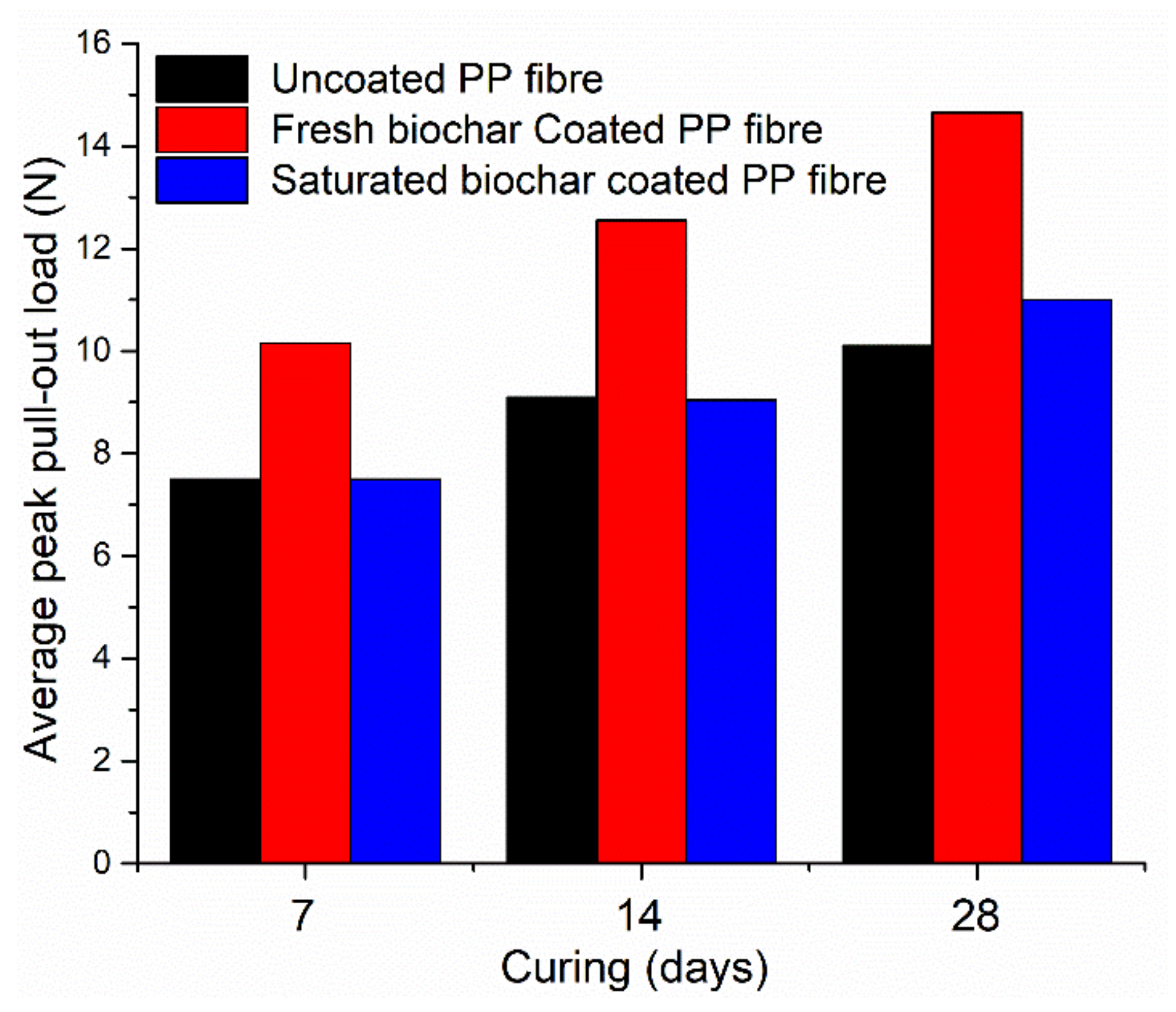
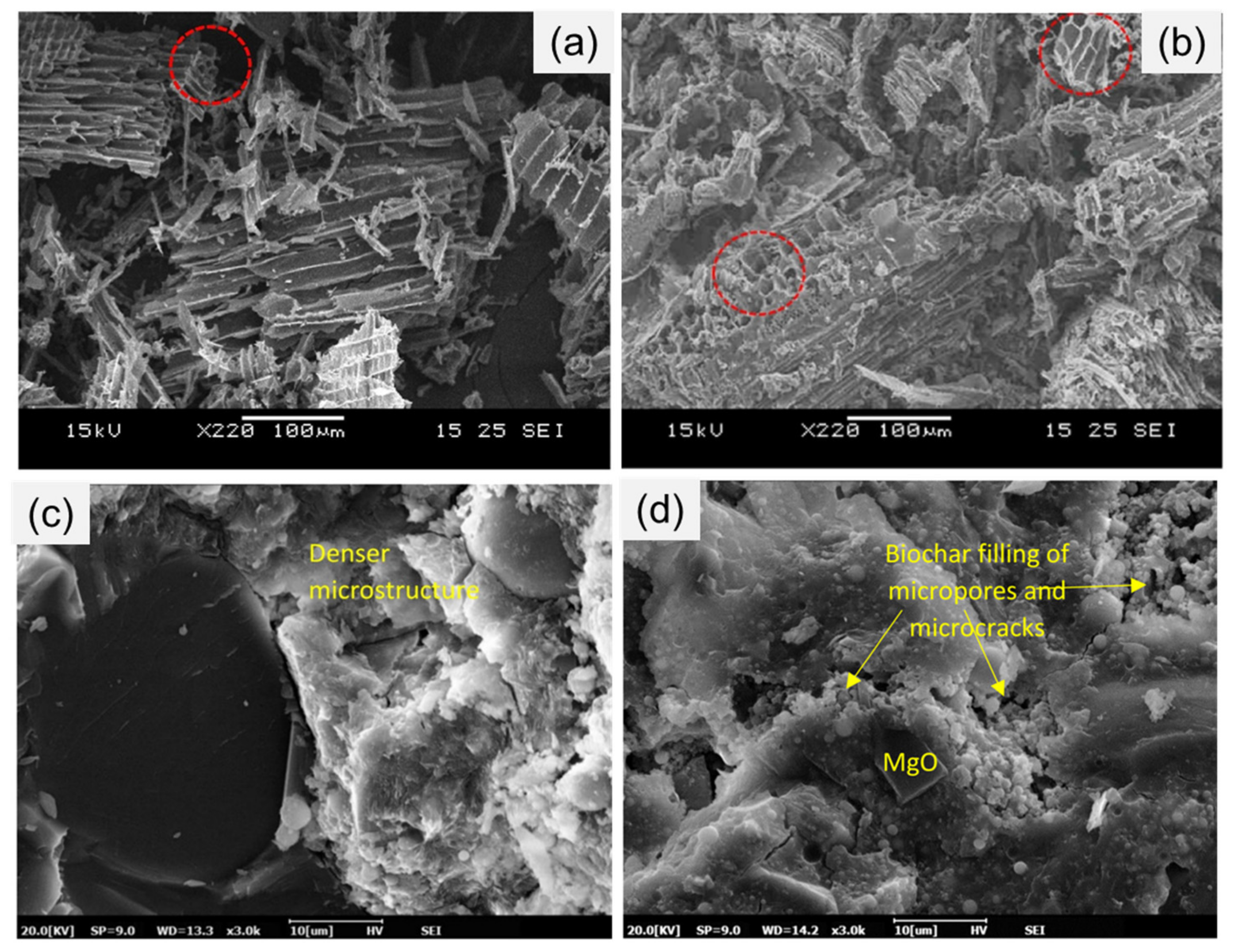
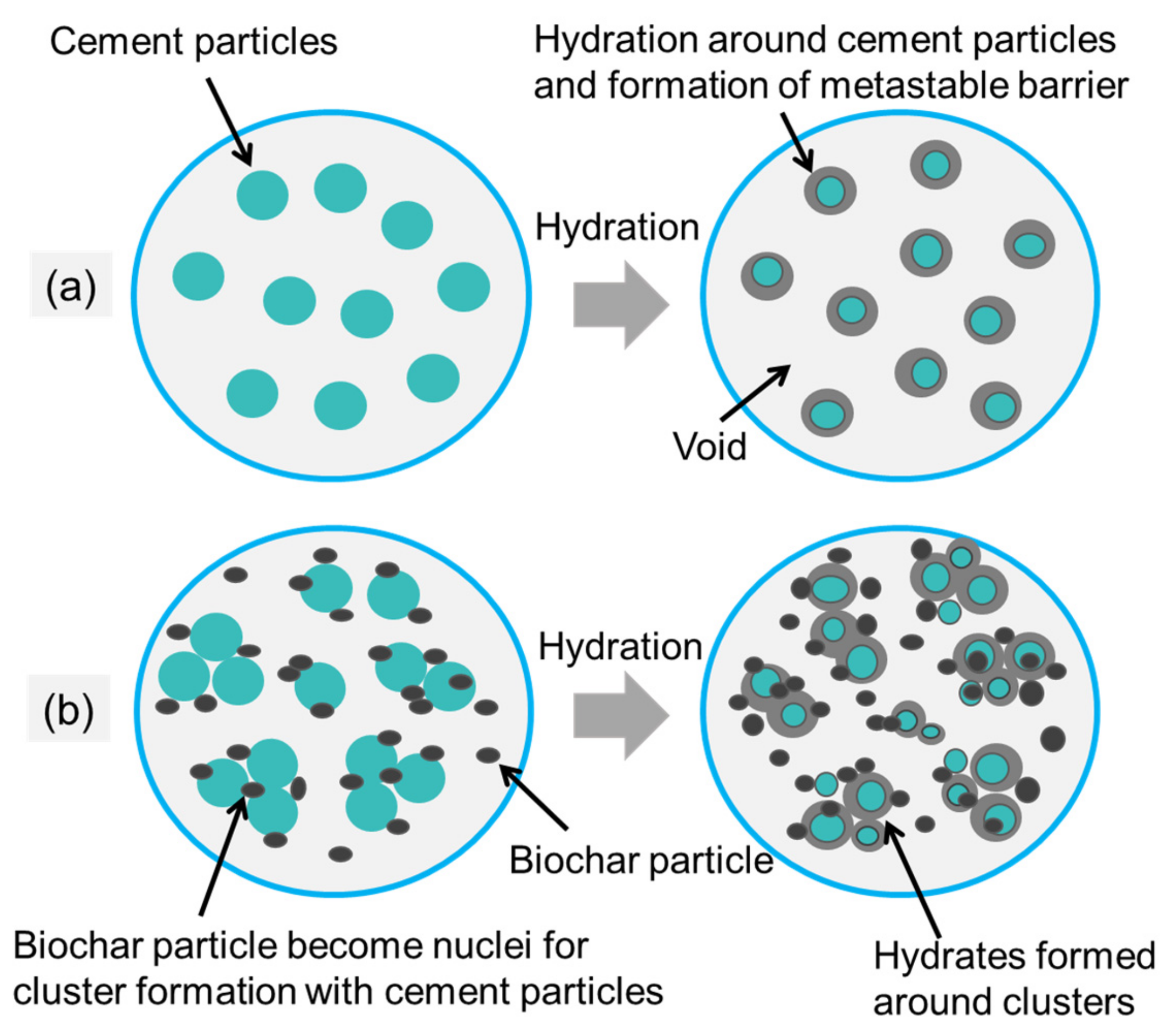
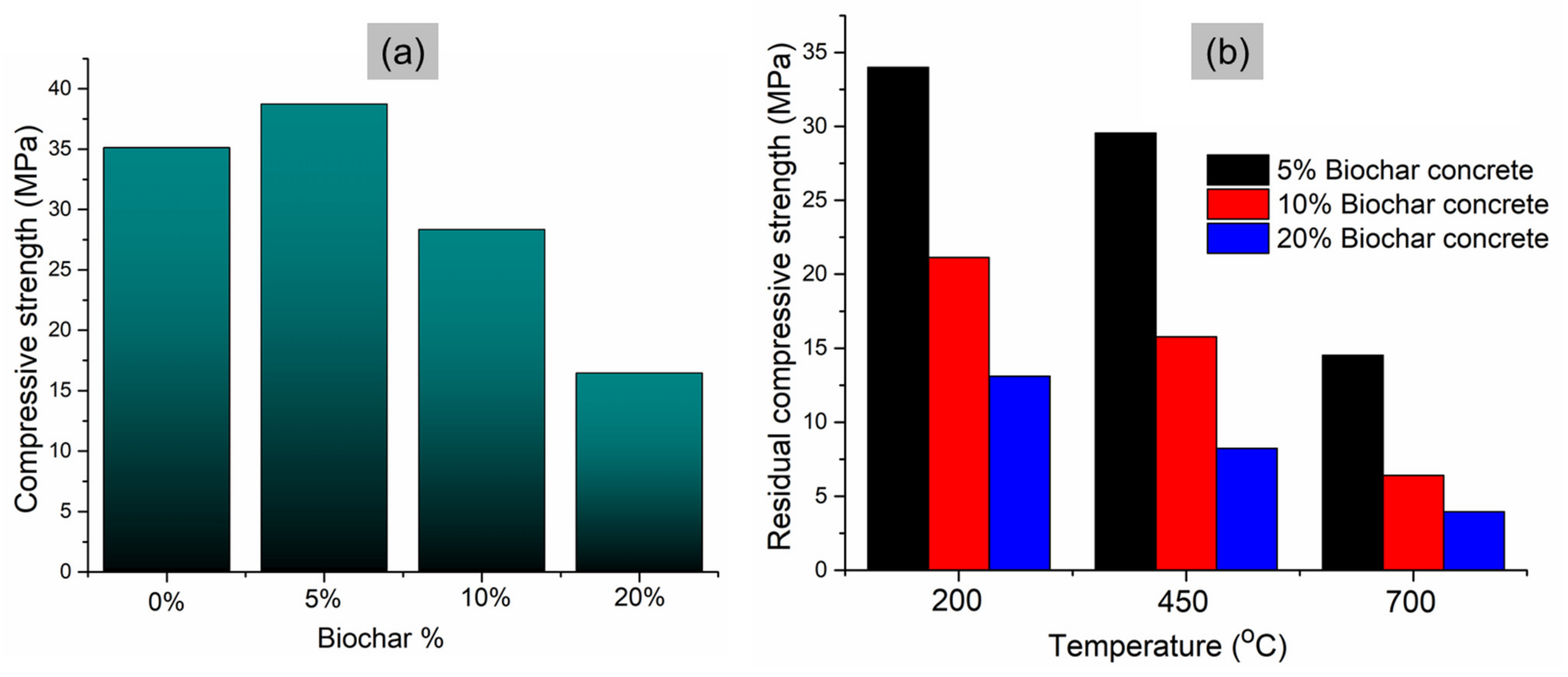
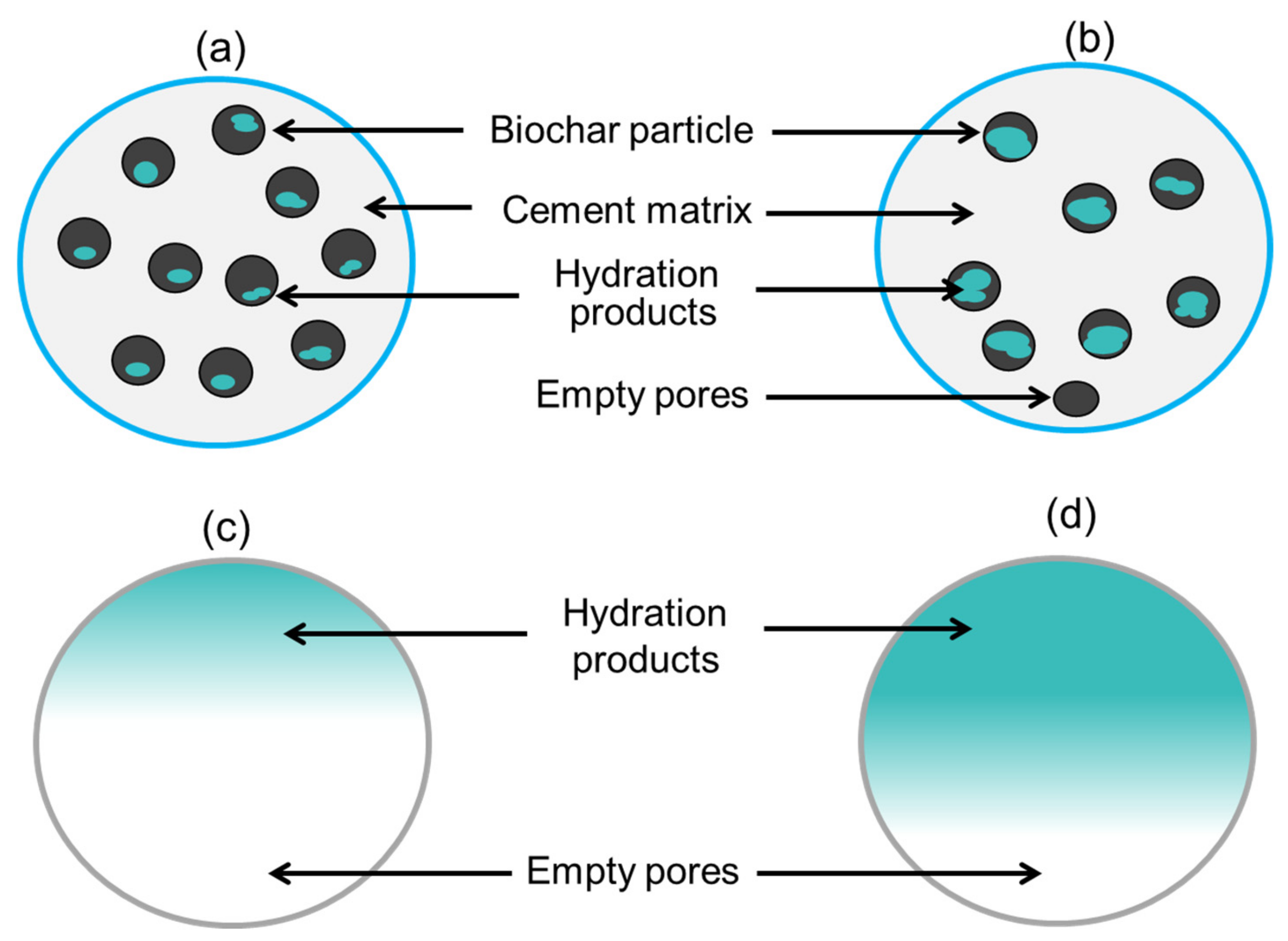

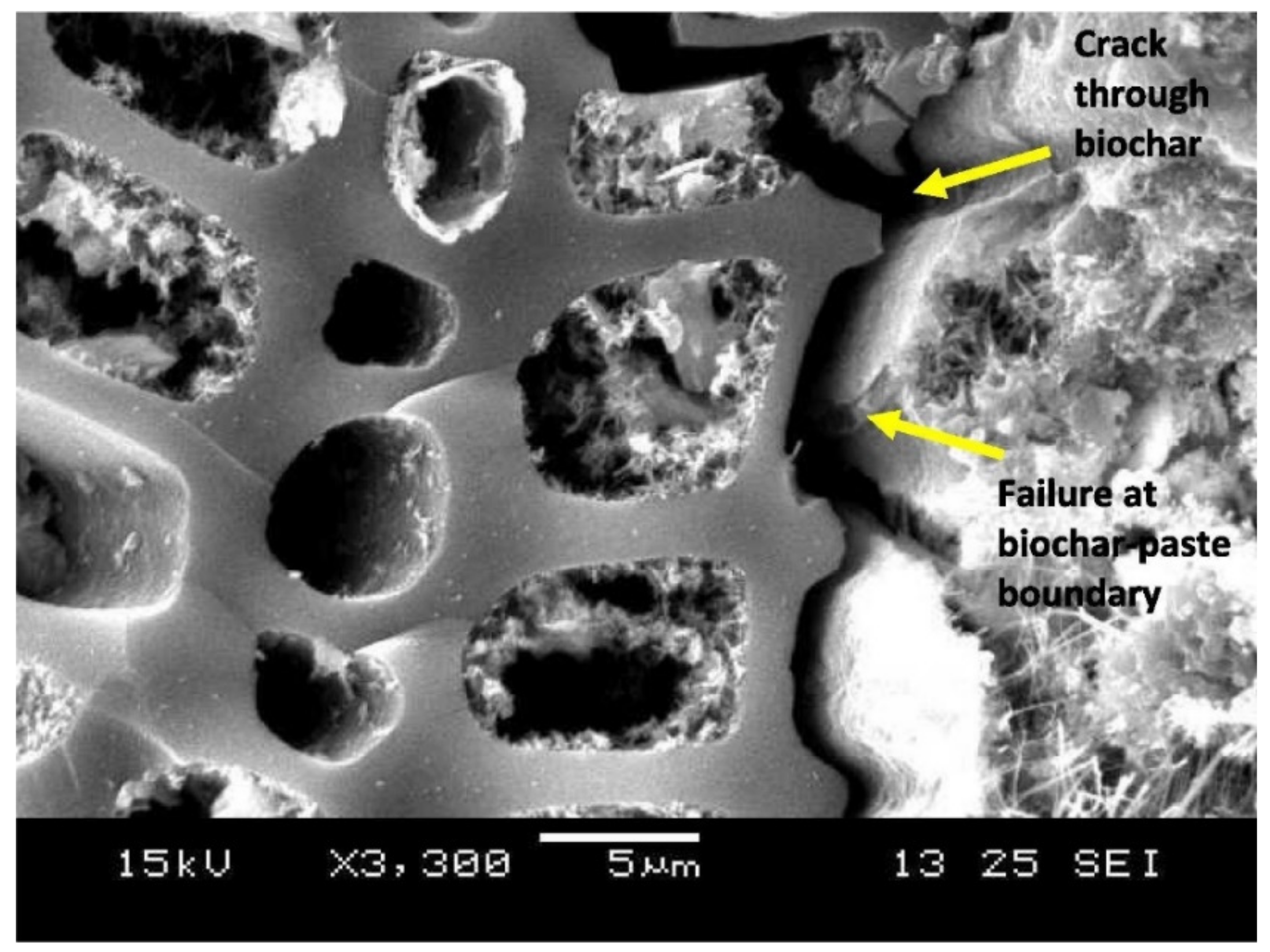
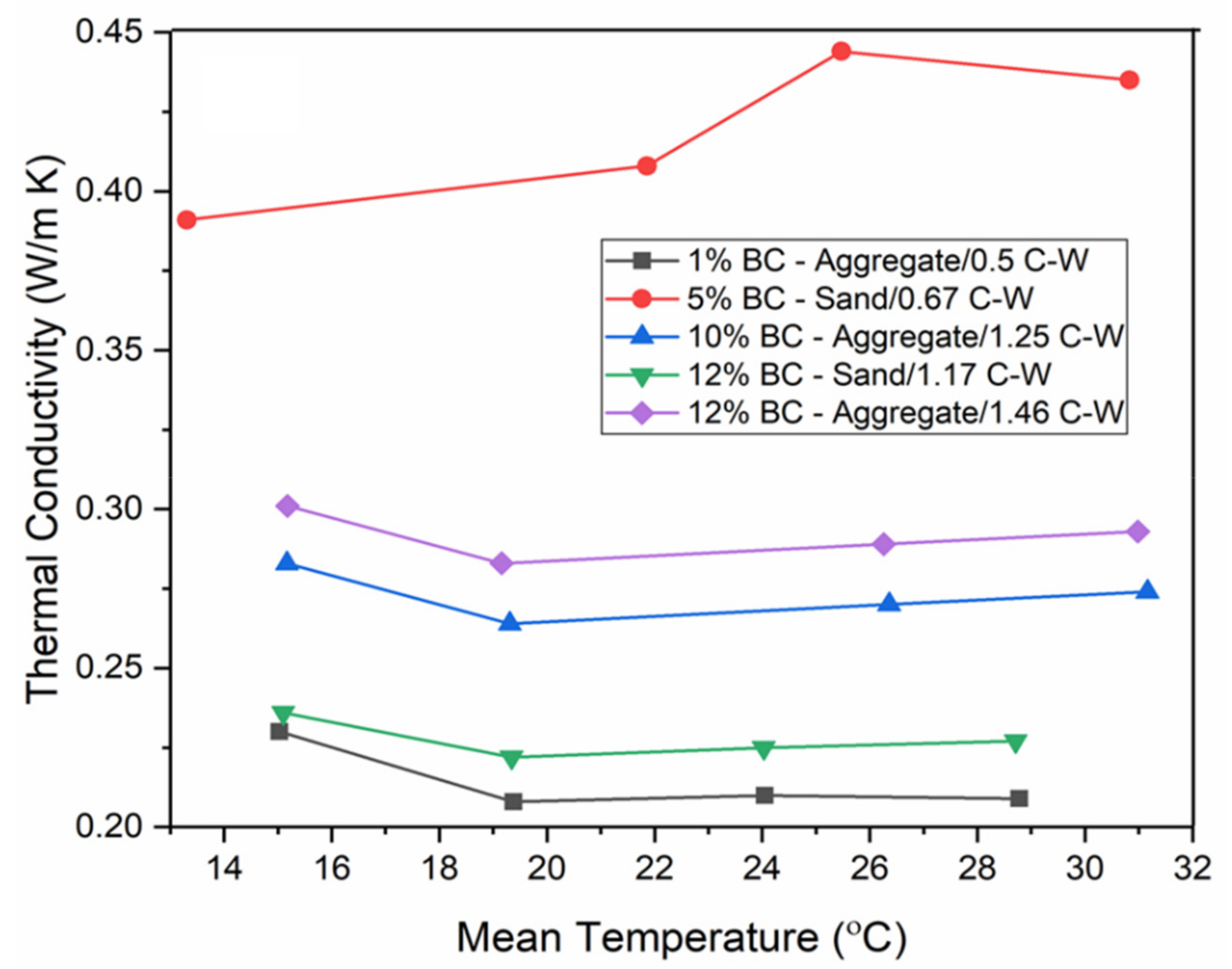
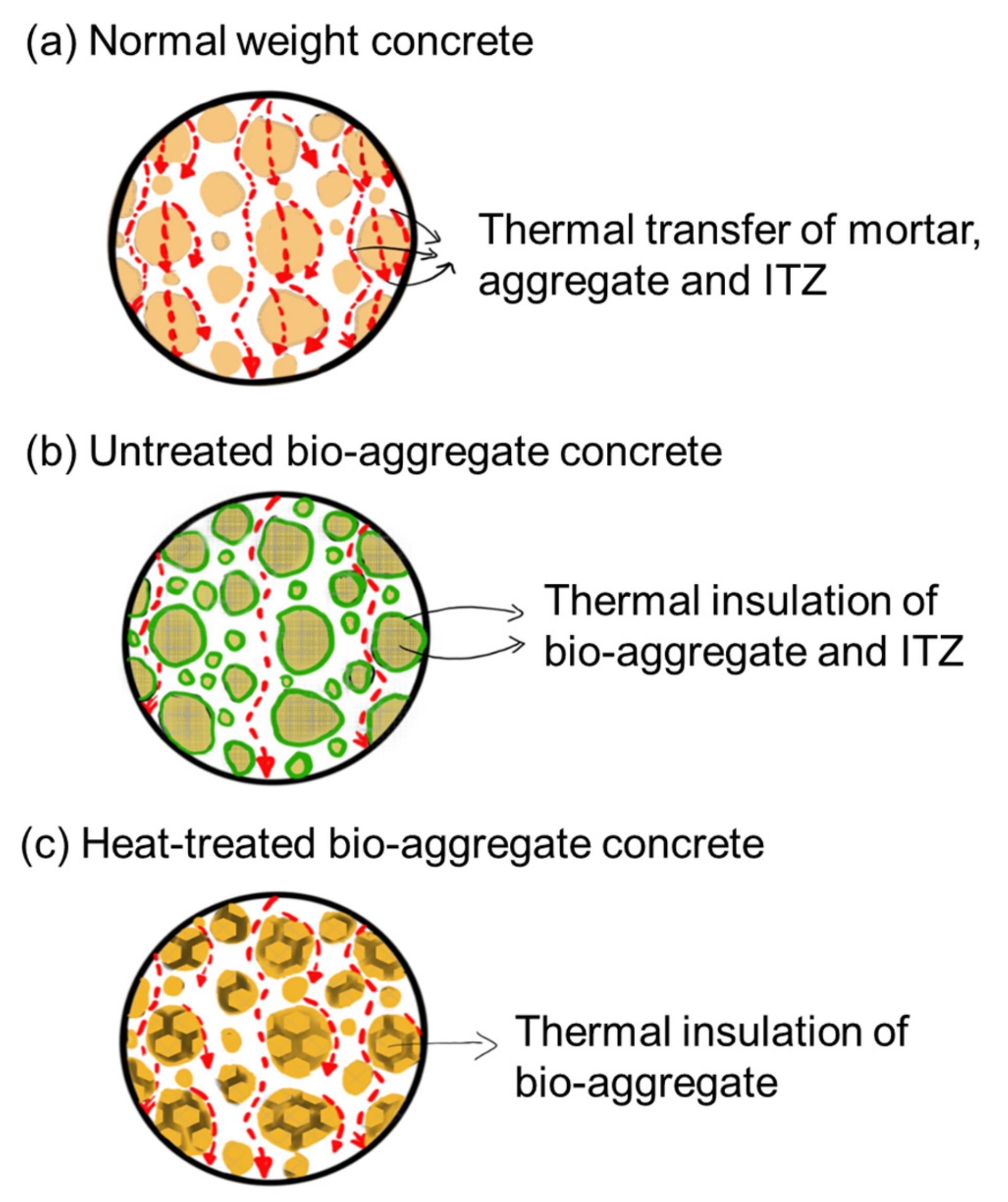
| Construction Material | Biochar Source | Bio Content and Size | Pyrolysis Conditions | Compressive Strength (MPa) | |||||
|---|---|---|---|---|---|---|---|---|---|
| 1 Day Curing | 3 Days Curing | 7 Days Curing | 14 Days Curing | 28 Days Curing | 30 Days Curing | ||||
| Cement Mortar | Rice husk [88] | 8% and 2–7 µm | Pyrolysis temperature is 500 °C at a rate of 1 °C/s | - | - | 55 * | - | 65 * | - |
| Ordinary Portland Cement | Poultry litter [66] | 0.1% | Slow pyrolysis of 450 °C and residence time is 20 min | - | - | 21 * | 27 * | 33 * | - |
| Ordinary Portland Cement | Pulp and Paper mill biochar [66] | 0.1% | Pyrolysis at 500 °C using high-temperature gasifier | - | - | 27 * | 31 * | 36 * | - |
| Ordinary Portland Cement | Rice husk [66] | 0.1% | Slow pyrolysis at 500 °C and residence time is 20 min | - | - | 26 * | 30 * | 35 * | - |
| Cement Mortar | Mixed wood [89] | 1% and 5–200 µm | Pyrolysis at a temperature of 500 °C and residence time is 45–60 min. Heating rate is 10 °C/min | - | - | 40 * | - | 58 * | - |
| Cement Mortar | Food waste [89] | 1% and 5–200 µm | Pyrolysis at a temperature of 500 °C and residence time is 45–60 min. Heating rate is 10 °C/min | - | - | 36 * | - | 54 * | - |
| Cement Mortar | Rice waste [89] | 2% and 5–200 µm | Pyrolysis at a temperature of 500 °C and residence time is 45–60 min. Heating rate is 10 °C/min | - | - | 36 * | - | 45 * | - |
| Cement Mortar | Saw dust [90] | 1% and 0.92–100 µm | Pyrolysis temperature is 500 °C and heating rate is 10 °C/min | 40.97 | - | - | - | 70.54 (Moist curing) 66 (Air curing) | |
| Magnesium Phosphate Cement | Wheat straw [72] | 1.5% and 2.05 µm | Pyrolysis temperature at 650 °C and at a heating rate of 18 °C/min | 75 * | - | - | - | - | 92 * |
| Ordinary Portland Cement | Chemically treated, Pyrolysed, and annealed bamboo [79] | 0.08% and 1–2 µm | Pyrolysis temperature is 850 °C and at a heating rate of 1 °C/min | - | - | - | - | 97 * | |
| Ordinary cement | Shell fish biowaste [91] | 0.1% | Pyrolysis temperature is 800 °C and at a heating rate of 5 °C/min | 21.11 | - | - | - | - | - |
| Cement mortar | Mixed sawdust [76] | 2 wt% and 5–500 µm | Pyrolysis between 300–500 °C and at a heating rate of 10 °C/min | - | - | 67 * | 70 * | 73 * | - |
| Ordinary Portland cement | Pre-treated Bagasse and Rice husk [77] | 5 wt% | Pyrolysis temperature at 700 °C for 2 hrs residence time and at a heating rate of 10 °C/min | - | - | - | - | Pre-treated rice husk–50 MPa Pre-treated Bagasse–55 MPa | - |
| Cement and flyash | Corn Stover [92] | 4 wt% and 4.65–144 µm | Pyrolysis temperature is 550 °C and at a heating rate of 15 °C/min | - | 40 * | - | 38 * | - | - |
| Cement Mortar | Wood chips [81] | 1 wt% and 38 µm | Pyrolysis temperature is between 200 and 500 °C and gasification temperature is 900 °C | - | 79 * | - | 90 * | - | - |
| Construction Material | Biochar Source | Bio Content and Size | Pyrolysis Conditions | Flexural Strength (MPa) | ||||
|---|---|---|---|---|---|---|---|---|
| 1 Day Curing | 7 Days Curing | 28 Days Curing | 30 Days Curing | 180 Days Curing | ||||
| Ordinary Portland Cement | Poultry litter [66] | 0.1% | Slow pyrolysis at 450 °C and residence time is 20 min | - | - | 5 * | - | - |
| Ordinary Portland Cement | Pulp and Paper mill biochar [66] | 0.1% | Pyrolysis at 500 °C using high-temperature gasifier | - | - | 4 * | - | - |
| Ordinary Portland Cement | Rice husk [66] | 0.1% | Slow pyrolysis at 500 °C and residence time is 20 min | - | - | 5 * | - | - |
| Cement Mortar | Mixed wood [89] | 1% and 5–200 µm | Pyrolysis at a temperature of 500 °C and residence time is 45–60 min. Heating rate is 10 °C/min | - | 11 * | 13 * | - | - |
| Cement Mortar | Food waste [89] | 1% and 5–200 µm | Pyrolysis at a temperature of 500 °C and residence time is 45–60 min. Heating rate is 10 °C/min | - | 10 * | 13 * | - | - |
| Cement Mortar | Rice waste [89] | 2% and 5–200 µm | Pyrolysis at a temperature of 500 °C and residence time is 45–60 min. Heating rate is 10 °C/min | - | 9 * | 11 * | - | - |
| Cement Mortar | Sawdust [90] | 1% and 0.92–100 µm | Pyrolysis temperature is 500 °C and heating rate is 10 °C/min | - | - | 11 (moist curing) 10 (air curing) | - | - |
| Magnesium Phosphate Cement | Wheat straw [71] | 1.5% and 2.05 µm | Pyrolysis temperature at 650 °C and at a heating rate of 18 °C/min | 10 * | - | - | 12 * | 13 * |
| Ordinary Portland cement | Soft wood [92] | 1% and <6 µm | Pyrolysis temperature at 680 °C and residence time is 12 min | - | 2 * | 2 * | - | - |
| Ordinary Portland Cement | Chemically treated, Pyrolysed and annealed bamboo [78] | 0.08% and 1–2 µm | Pyrolysis temperature is 850 °C and at a heating rate of 1 °C/min | - | - | 4 * | - | - |
| Ordinary cement | Shellfish biowaste [92] | 0.1% | Pyrolysis temperature is 800 °C and at a heating rate of 5 °C/min | 2 | - | - | - | - |
| Cement mortar | Mixed sawdust [75] | 2 wt% and 5–500 µm | Pyrolysis between 300–500 °C and at a heating rate of 10 °C/min | - | - | Moist curing–13 * Air curing–11 * | - | - |
| Cement Mortar | Wood chips [80] | 1 wt% and 38 µm | Pyrolysis temperature is between 200 and 500 °C and gasification temperature is 900 °C | - | 5 * | 6 * | - | - |
Publisher’s Note: MDPI stays neutral with regard to jurisdictional claims in published maps and institutional affiliations. |
© 2021 by the authors. Licensee MDPI, Basel, Switzerland. This article is an open access article distributed under the terms and conditions of the Creative Commons Attribution (CC BY) license (https://creativecommons.org/licenses/by/4.0/).
Share and Cite
Mensah, R.A.; Shanmugam, V.; Narayanan, S.; Razavi, N.; Ulfberg, A.; Blanksvärd, T.; Sayahi, F.; Simonsson, P.; Reinke, B.; Försth, M.; et al. Biochar-Added Cementitious Materials—A Review on Mechanical, Thermal, and Environmental Properties. Sustainability 2021, 13, 9336. https://doi.org/10.3390/su13169336
Mensah RA, Shanmugam V, Narayanan S, Razavi N, Ulfberg A, Blanksvärd T, Sayahi F, Simonsson P, Reinke B, Försth M, et al. Biochar-Added Cementitious Materials—A Review on Mechanical, Thermal, and Environmental Properties. Sustainability. 2021; 13(16):9336. https://doi.org/10.3390/su13169336
Chicago/Turabian StyleMensah, Rhoda Afriyie, Vigneshwaran Shanmugam, Sreenivasan Narayanan, Nima Razavi, Adrian Ulfberg, Thomas Blanksvärd, Faez Sayahi, Peter Simonsson, Benjamin Reinke, Michael Försth, and et al. 2021. "Biochar-Added Cementitious Materials—A Review on Mechanical, Thermal, and Environmental Properties" Sustainability 13, no. 16: 9336. https://doi.org/10.3390/su13169336
APA StyleMensah, R. A., Shanmugam, V., Narayanan, S., Razavi, N., Ulfberg, A., Blanksvärd, T., Sayahi, F., Simonsson, P., Reinke, B., Försth, M., Sas, G., Sas, D., & Das, O. (2021). Biochar-Added Cementitious Materials—A Review on Mechanical, Thermal, and Environmental Properties. Sustainability, 13(16), 9336. https://doi.org/10.3390/su13169336















